Contra MC
Wheel Size: 27.5’’ (Size XS); 29’’ front / 27.5’’ rear (Size S); 29’’ (Sizes M–XXL)
Travel: ~165 mm rear / 160 or 170 mm front (varies slightly by size)
Geometry highlights:
- Sizes offered: XS, S, M, L, XL, XL
- Headtube angle: 63.5°
- Reach: 480 mm (size Large)
- Seat tube angle: 78°
- Chainstay length: 438 mm (Size Large)
Frame material: Steel
Price: Frame w/ EXT Era shock: $4,500
Blister’s Measured Weight (size XL, as built): 38.7 lb / 17.6 kg
Test Locations: Washington & British Columbia
Reviewer: David Golay: 6’, 170 lbs / 183 cm, 77.1 kg
Test Duration: 3.5 months
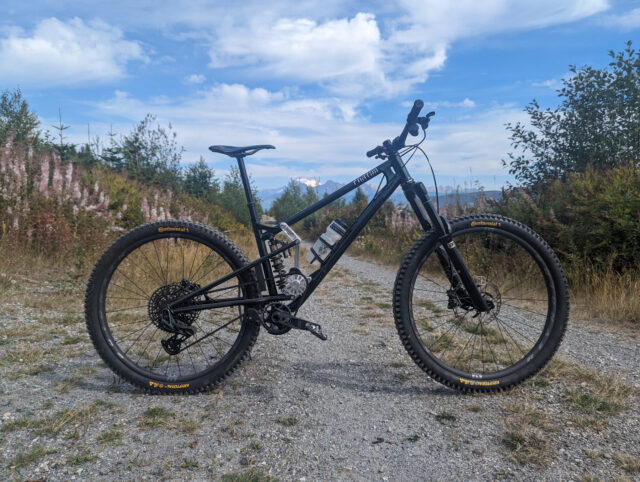
Intro
Contra is a new bike brand started by Evan Turpen, with the goal of building his ideal Enduro race bike, and the resulting bike — the Contra MC — looks incredibly interesting.
Evan and I did a much more detailed rundown of the Contra story back in Episode 118 of Bikes & Big Ideas, which you should definitely check out to hear a whole lot more about Evan’s thinking behind the bike, and the process behind getting Contra off the ground — and we’re planning a follow-up episode about moving into full-scale production that we’re excited to share with you soon.
I caught up with Evan in Santa Cruz to get a first ride on the MC and my initial impressions are quite positive. We’ll be getting an MC in for a proper long-term review in a bit, but to kick things off, here’s the rundown on the bike:
The Frame
The MC is made primarily out of steel, using a dual mini-link layout with machined aluminum links, and a high virtual pivot design that necessitates the use of an idler pulley to keep the anti-squat in check. A third aluminum link running between the main two makes the linkage look more complex than it actually is — that third link is better thought of as the third side of the rear triangle, and serves to tie the swingarm together, rather than acting as a true link in the suspension. The MC gets about 165 mm of rear wheel travel (with smaller sizes getting very slightly less, due to their shorter chainstays), and the MC is designed around a 160mm-travel fork (sizes XS and S) or a 170mm-travel one (sizes M–XXL). The XS MC uses dual 27.5’’ wheels to keep the stack height in check for shorter folks and make the rear-tire-to-butt clearance more manageable; the Small frame bumps up to a 29’’ front wheel for a mullet configuration, and the Medium through XXL frames are full 29ers. The MC is dual crown compatible if you’re so inclined, with Contra recommending a 190mm-travel fork paired with a zero-stack lower headset cup to minimize the resulting geometry changes.
The idler pulley on the MC is unusually large (at 24 teeth) and is positioned farther forward than on most other high-pivot bikes with the goal of reducing drag and improving the chainline. Since each individual chain link has to move through a smaller angle to wrap around the idler, and because the load is spread over more teeth, Contra says that the MC has less chain drag than many other high-pivot bikes. And because the pulley is positioned farther forward in the frame, the chain doesn’t have to bend laterally across as wide an angle to move through the full range of gears as it would if the pulley were more rearward (and therefore closer to the cassette). A lower chainguide to increase chain wrap around the chainring is included with the MC frame. That guide also means that there’s very little lower chain growth as the MC cycles through its suspension travel, so the derailleur cage doesn’t have to move very far to maintain chain tension, meaning that the derailleur clutch should have less of an impact on suspension performance than it does on many other bikes.

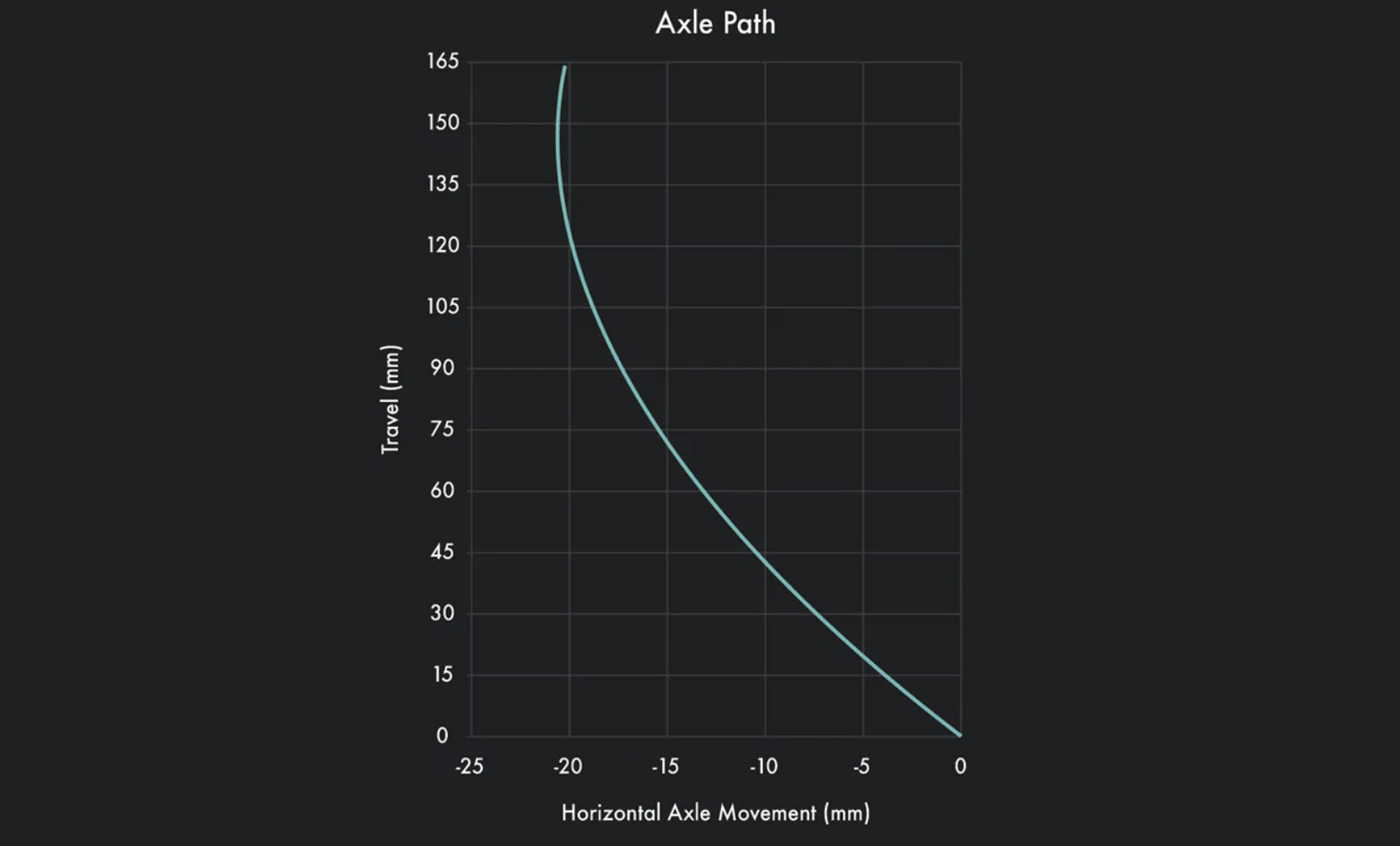
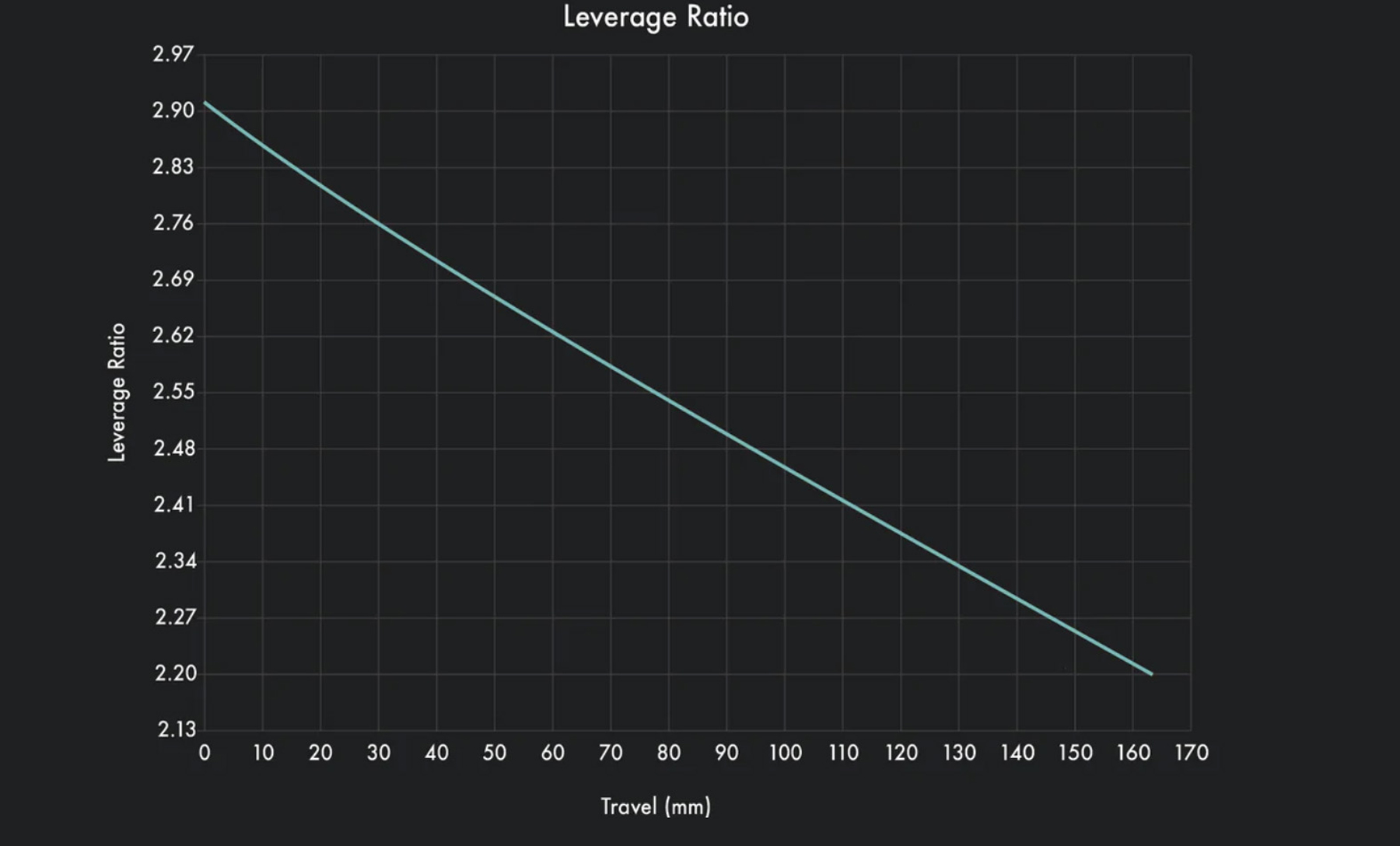
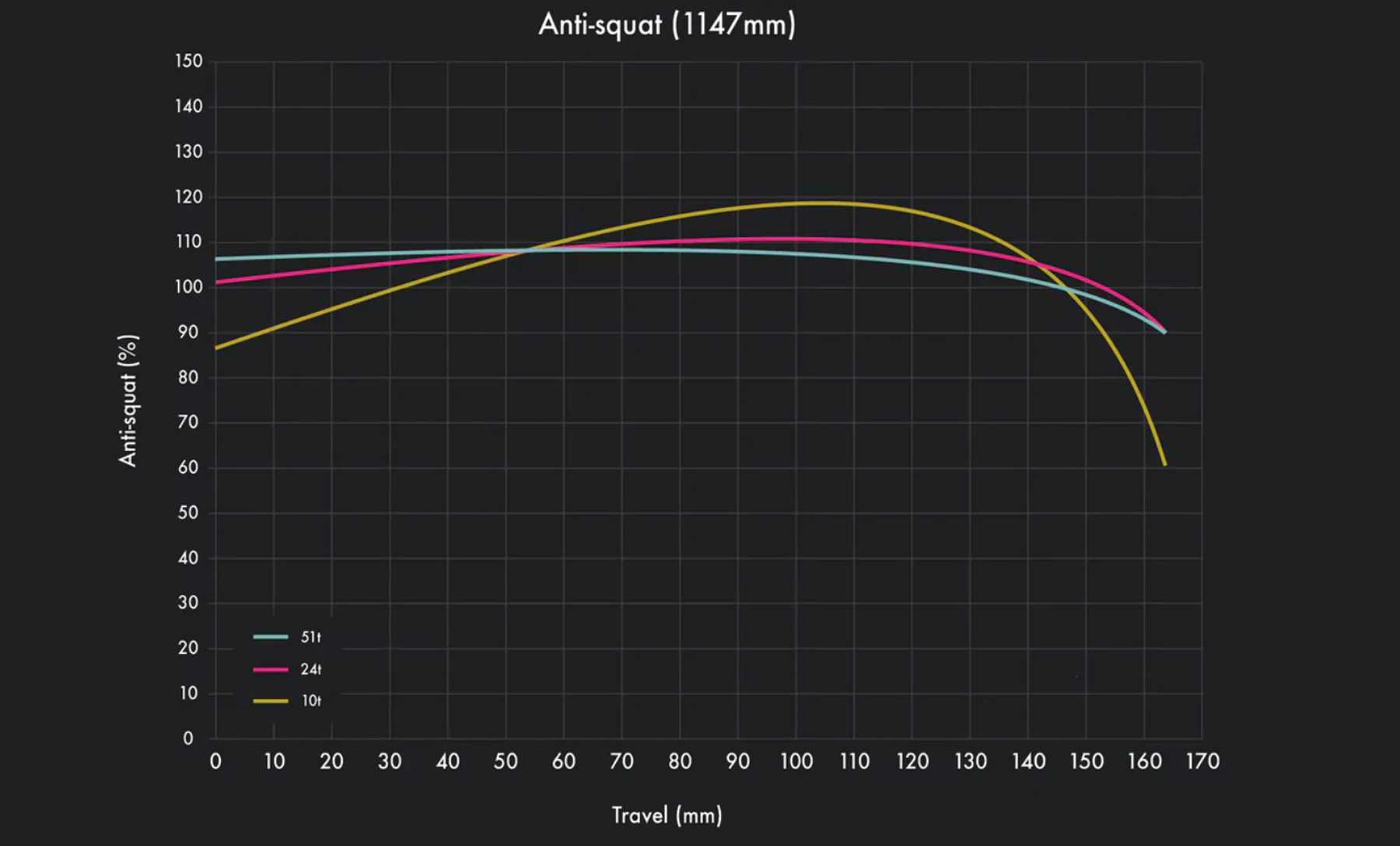
Contra says that that leverage curve is suitable for both air and coil shocks, and in theory that checks out. Contra hasn’t been able to check every shock out there yet but can confirm that the Push Eleven-Six doesn’t fit, and suspects that the same is true of the Ohlins TTX22 and Formula Mod. Most other options are believed to fit, but Contra recommends a test fit if you’re planning to run something other than the stock EXT Storia.
The other details are suitably no-nonsense, for what is meant to be an Enduro race bike first and foremost. The bottom bracket is threaded, the cable routing is external, there’s room for a full-size water bottle inside the front triangle on all the frame sizes, and the derailleur hanger is a SRAM UDH. The rear brake mount takes a 200 mm rotor directly, and there’s clearance for up to a 223 x 2.3 mm rotor if you want to go up from there. All eight pivot bearings are double-row Enduro 3208 Max-type.
A big part of the Contra vision was to build frames in the US, and almost all of the parts are made in California, with all the frame mitering, welding, finishing, and assembly being done in Santa Cruz County; most of the machined parts are also made in Central CA, apart from the chainguide which is made in Oregon.
Fit & Geometry
The MC is offered in six sizes, XS through XXL, with the reach ranging from 420 to 520 mm in neat 20 mm increments. The headtube angle sits at 63.5° across the board and is paired with a very-steep 78° actual seat tube angle. The chainstay length varies by frame size, going from 420 to 460 mm in 6 mm increments (for 438 mm on the Large frame); that length grows by about 14 mm at sag, due to the very rearward axle path.
In part due to the very steep seat tube and resulting shorter effective top tube, Contra recommends slightly aggressive sizing on the MC, with the Medium frame (460 mm reach suggested for folks 5’6’’ to 5’10’’ (168 to 178 cm) and the Large for 5’9’’ to 6’1’’ (175 to 185 cm) riders. That puts me (6’ / 183 cm) right on the border of the Large and XL sizes, but after some conversations with Evan, we’re planning on an XL review bike in the spring — so stay tuned for more on that, soon. Contra also has designed their jig for the MC frames to have the ability to adjust the reach by +/- 10mm in a given size (so if you want an XL with a 490 mm reach, or a Small with 450 mm, for example), they can accommodate that.
Overall, the geometry looks sensible for an aggressive Enduro bike — long and slack without being totally over the top, with a moderately low bottom bracket (33 mm drop on the 29er sizes, or 15 mm relative to a 27.5’’ rear wheel). The stack height is also a touch on the tall side (640.7 mm on the Large) but again, nothing way outside of the norm. The seat tube is also notably short to maximize clearance for long dropper posts.
The Builds
For now, Contra offers the MC as a frame only, with an EXT Storia V3 rear shock for $4,500. The custom chain guide (which includes a bash guard and lower roller, plus a guide for the idler pulley) and a Bike Yoke Squeezy seatpost clamp are also included. The MC is available for pre-order with frames scheduled to ship in the spring of 2023.

Some Questions / Things We’re Curious About
(1) The Contra MC looks like a very well-thought-out Enduro race bike, but how does it all come together on the trail?
(2) For the other side of that coin, does the MC feel like a super game-on bike that needs to be pushed quite hard to come alive, or does it feel more easy-going and versatile than that?
(3) And how does the MC stack up in the ever-growing category of high-pivot Enduro bikes, including the Norco Range, Cannondale Jekyll, Kavenz VHP 16, Forbidden Dreadnought, Deviate Claymore, and more?
FULL REVIEW
I’d been excited to get on the Contra MC since I first laid eyes on the prototype at Sea Otter 2022, and then talked to founder Evan Turpen about his approach to designing the frame. (Check out Ep.118 and Ep.193 of Bikes & Big Ideas for a whole lot more on that.) The Contra MC’s geometry, suspension kinematics, and overall design philosophy struck me as very promising, but how would it all come together in practice?
I’ve now ridden two sizes of the MC over a lot of vert in a lot of different terrain, and it’s time to weigh in on how it performs.
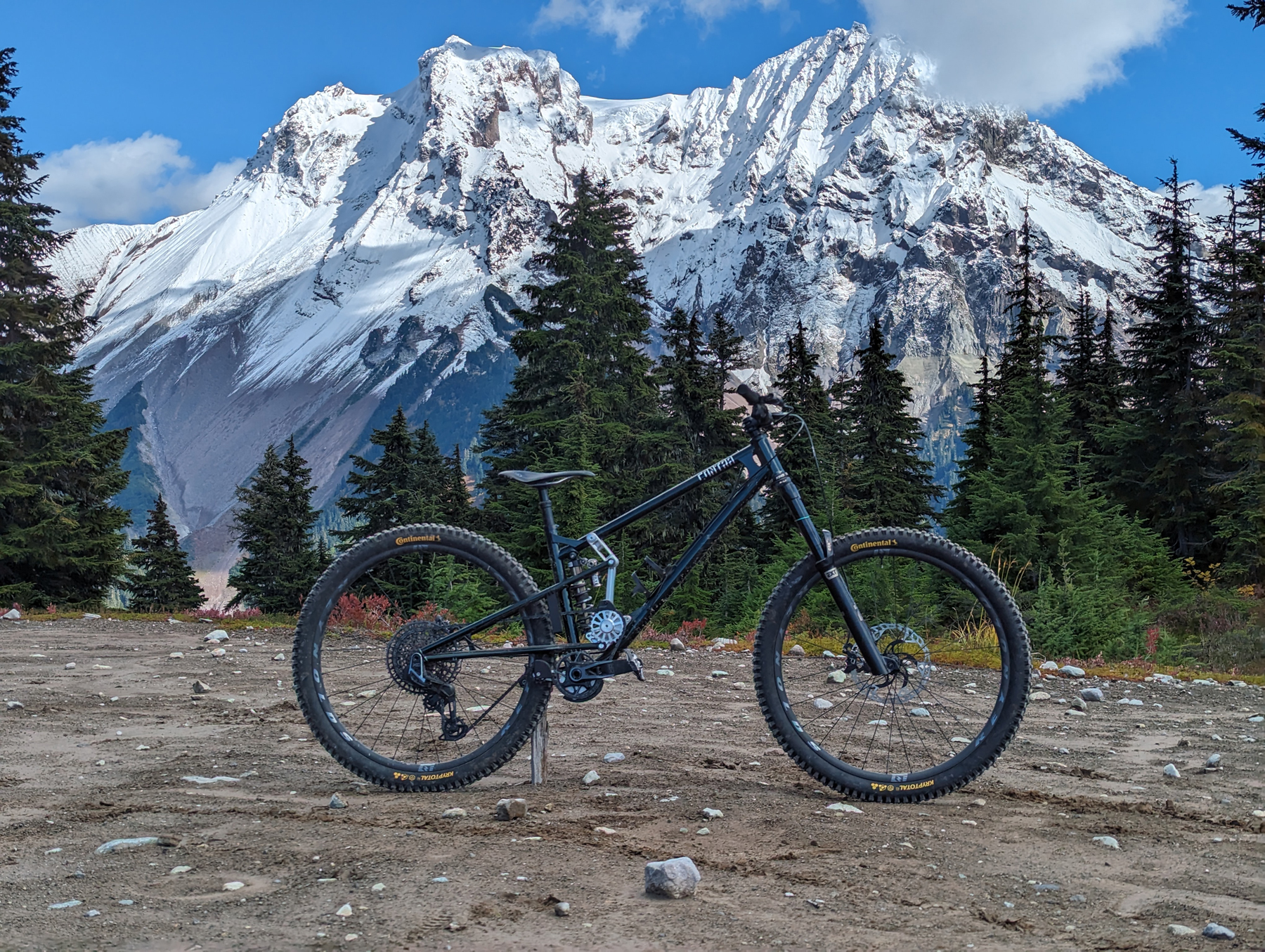
Fit & Sizing
At 6’ (183 cm) tall, I’m on the border between Contra’s recommended sizing for the Large and XL frames, but after chatting with Evan, he steered me toward the XL frame, and I think that was the right call. With 480 and 500 mm of reach, respectively, the Large and XL frames more or less bracket my typical preferred range for a bigger Enduro bike. But between its quite-steep seat tube (and correspondingly short effective top tube) and the MC’s positioning as a more stable, composed sort of bike, it seemed like a case where sizing up was the way to go.
I actually got a first ride on the MC early in 2023 on Evan’s personal size Large frame, which helped cement the call to size up to the XL. I could ride the Large just fine, but the seated cockpit felt on the short side, and that compact position felt like it might be fatiguing on longer, steeper climbs in particular. Once I stood up and started descending, the Large felt plenty workable, but a bit smaller / with a little less room to move around than I’d ideally prefer.
So we stuck with the plan and went with an XL for our review bike, and I haven’t second-guessed that decision at all. Any concerns I might have had about the XL MC being too much to manage in tighter, more awkward spots have proven to be unfounded, and I had a very quick and easy time getting comfortable on the XL MC.
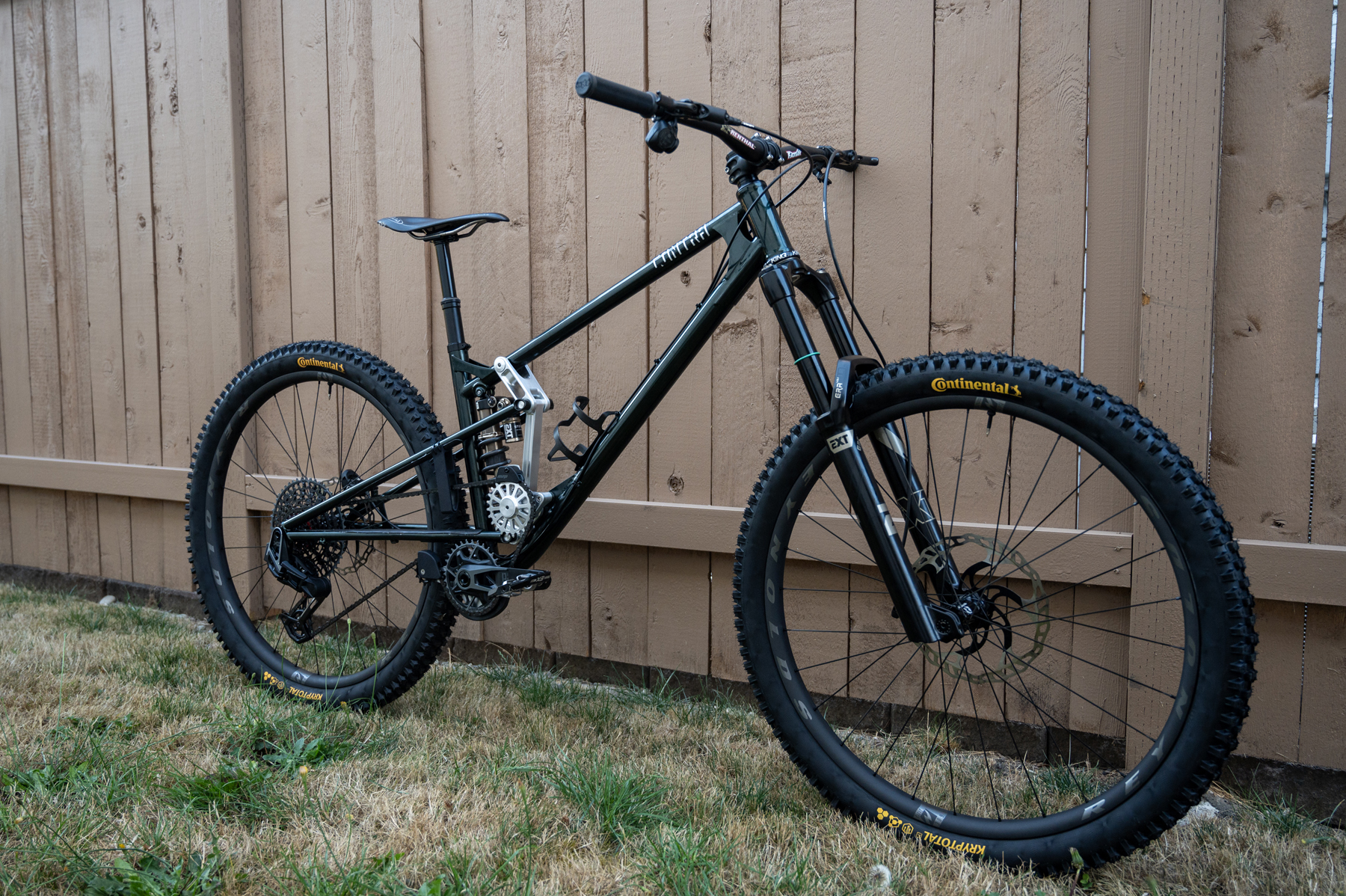
Its tall stack height is also welcome. I understand going lower on a more all-rounder Trail bike to make it easier to get over the front end on more rolling terrain, but for a winch-and-plummet-focused bike like the MC, the tall-ish stack height makes it easier to get the bars as high as I’d like for descending steeper trails. I wound up running the MC with a 20mm-rise handlebar and 10 mm of spacers underneath the stem — far less than I have on a lot of bikes in this category. That all makes the cockpit setup a bit less fiddly and makes for a slightly stiffer interface as compared to running a ton of spacers and/or a higher-rise bar.
Climbing
There’s a big spectrum among various longer-travel Enduro bikes (both high-pivot and otherwise) when it comes to pedaling efficiency, and the MC is one of the better ones I’ve recently tried on that front. As you’d probably expect for a 165mm-travel bike that weighs upwards of 38 lbs as-built, it’s not super sprightly on the way up, but if your goals are more of the sit-and-spin variety, rather than trying to set climbing KOMs, the MC does quite well. That above-average pedaling efficiency is paired with very impressive traction under power, making the MC especially good at grinding up steep, loose climbs when rear-wheel grip is at a premium.
As you’d expect from a bike with a wheelbase just over 1,300 mm (and a pretty low bottom bracket), it starts to feel like more of a handful when the climbs start getting really tight, awkward, and stair-step-y, but the MC does pretty well for what it is there, too.
The Contra MC’s super-steep 78° actual (and effective) seat tube angle definitely helps there, making it extremely easy to keep the front wheel planted on even the very steepest climbs. The MC’s pedaling position feels dialed to me, given the intended purpose of the bike. It’s very steep and upright overall, but in a way where seated pedaling on flat ground doesn’t feel awkward, either. If the MC were a more all-rounder Trail bike and less of a game-on winch-and-plummet one, I might be arguing to dial back the seat tube angle a touch. However, it’s excellent for a bike where I’m rarely trying to put down huge watts while seated on flatter ground, or stand up and really attack on shorter, punchier climbs.
I’ve yet to ride a high-pivot bike where its pedaling efficiency (due to drivetrain drag) doesn’t fall off more rapidly than bikes with a conventional drivetrain layout, as the chain gets muddy and loses lubrication. The MC feels at least a little better than most on that front, but it’s not immune from that tradeoff, either. The Contra MC’s especially large 24-tooth idler pulley and that pulley’s notably forward placement probably deserve some credit for the MC faring better than many other high-pivot bikes there, but the tradeoff is still real.
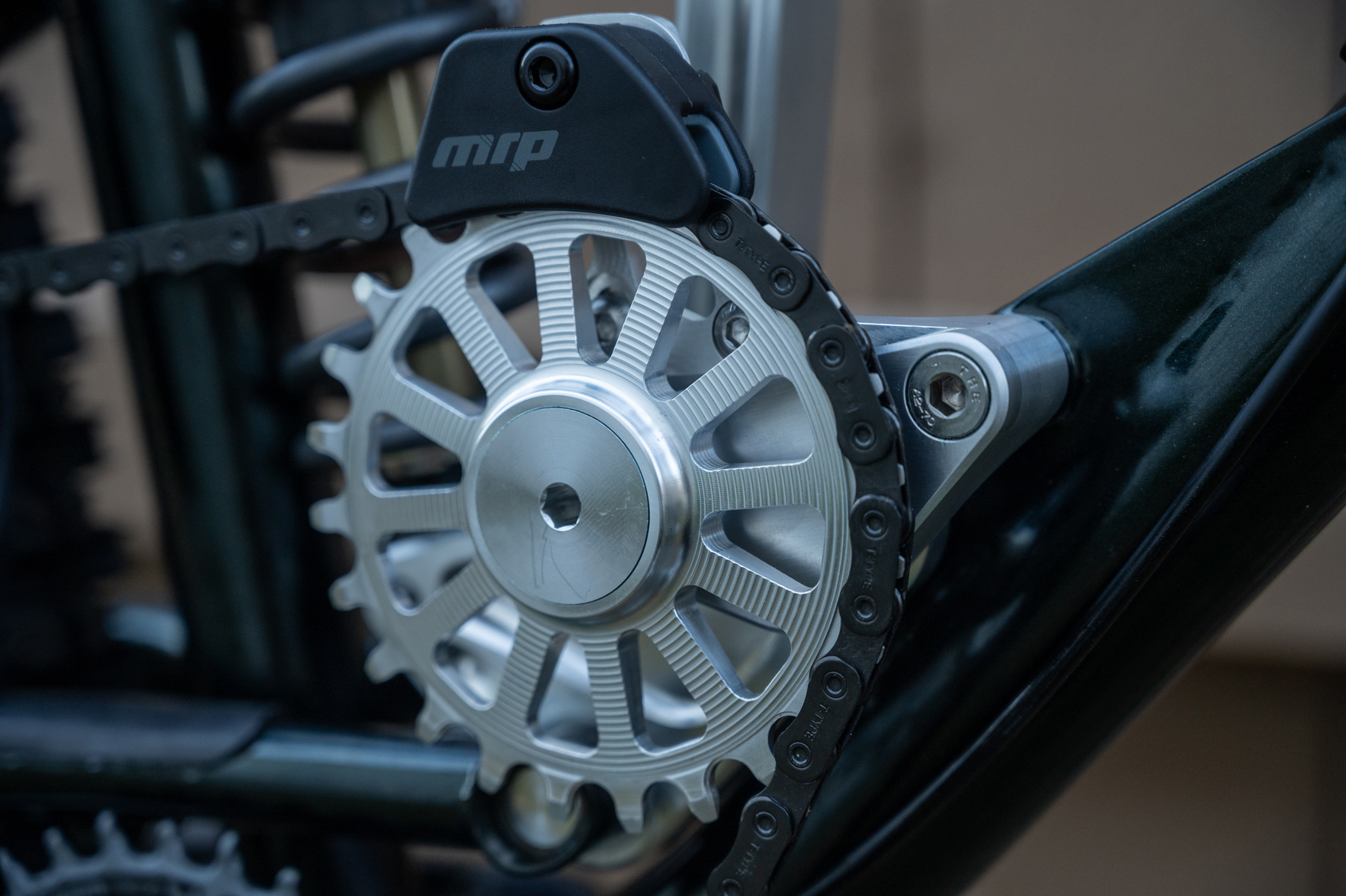
If you’re, say, doing 8,000’+ vert days in the rain, the MC does start to exhibit noticeably more drag than bikes without a high-pivot / idler arrangement. (I’ve done a few of those on it and, while the MC wouldn’t be my first choice, it was fine.) For most people on most rides, I don’t think it’ll be a big deal so long as you stay on top of a basic drivetrain cleaning / lubrication program.
Descending
I kicked off my time on the MC by taking it on a road trip through coastal British Columbia, much of which was spent chasing a couple of very fast locals on some steep, technical trails that I was unfamiliar with. The Contra MC proved to be an ideal companion for that mission. It’s extremely composed and confidence-inspiring while going very, very fast on rough, technical trails, and it’s forgiving of mistakes when you’re pushing hard.
[I had what I think has to be my save of the year for 2023 onboard the MC on that BC trip. I pulled for a gap over a hole on a steep, raw, freshly-cut trail but didn’t see the second hole in what was to be my landing until it was too late. I buried the front wheel hard enough to twist the stem about 30 degrees on the steerer tube, but managed to ride it out.]
I’ve actually found myself missing braking points on the MC after going back to it from a couple of the other bikes I’ve been spending time on recently — even after having spent a lot of time on the MC, and on trails that I know well. This bike just carries speed so well, and does so with such composure that it’s sometimes messed with my brain’s calibration of how fast I’m going. I’ve quickly re-adjusted again in each instance, but I’ve been caught out more than once.
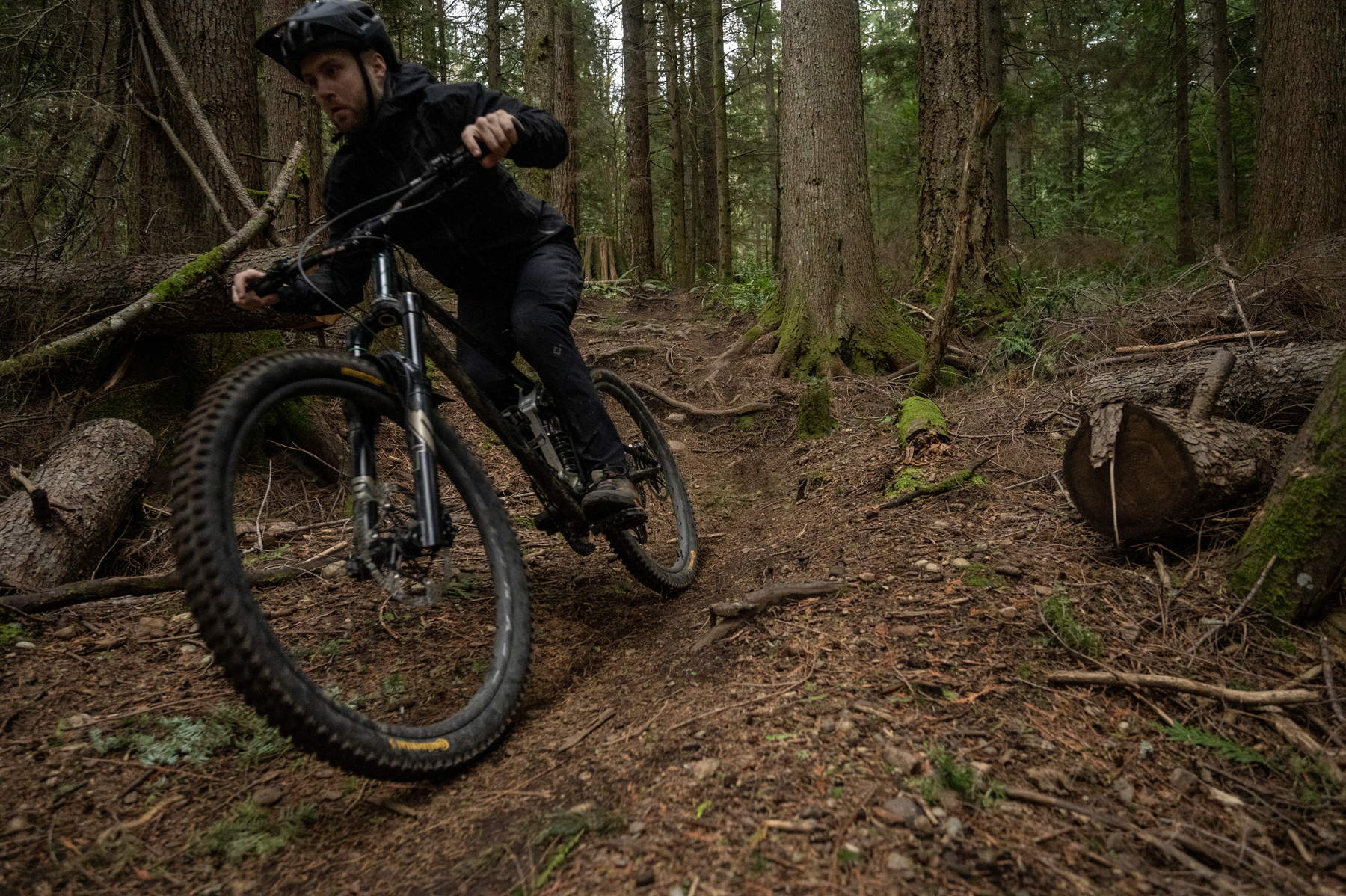
Unsurprisingly, given how stable and composed it is at speed, the MC isn’t the most lively or poppy-feeling bike out there, but it’s more well-rounded than I might have expected. The MC is still definitely on the more planted / less energetic end of the spectrum for 160+mm-travel bikes, but it’s happy enough to take to the air when called upon and doesn’t feel as emphatically glued to the ground as, say, the Norco Range, for example.
The MC isn’t super energetic and lively but feels natural and intuitive when jumping and popping off stuff. As is generally the case with high-pivot bikes, it takes some extra effort to build speed on the MC by pumping through things, as compared to a lot of bikes with a conventional drivetrain layout (and, probably more operatively, a less rearward axle path), but the MC does alright for what it is.
For a bike that’s as composed and capable of being pushed so hard, the MC also does a very respectable job of feeling manageable and not overly demanding in terms of being ridden super precisely and aggressively at all times. That’s not to say that it’s a bike that I’d recommend to folks who don’t intend to spend most of their time with it on steep, technical trails, trying to go fast on them. It’s not very engaging or exciting if you’re taking things easier, or riding mellower, smoother trails.
The MC just doesn’t feel like it’s fighting you and demanding that you really rally on it to feel comfortable and manageable. That’s in definite contrast to some of the more stable, game-on bikes out there, many of which can feel like a handful until you start pushing them hard and fast enough to come alive.
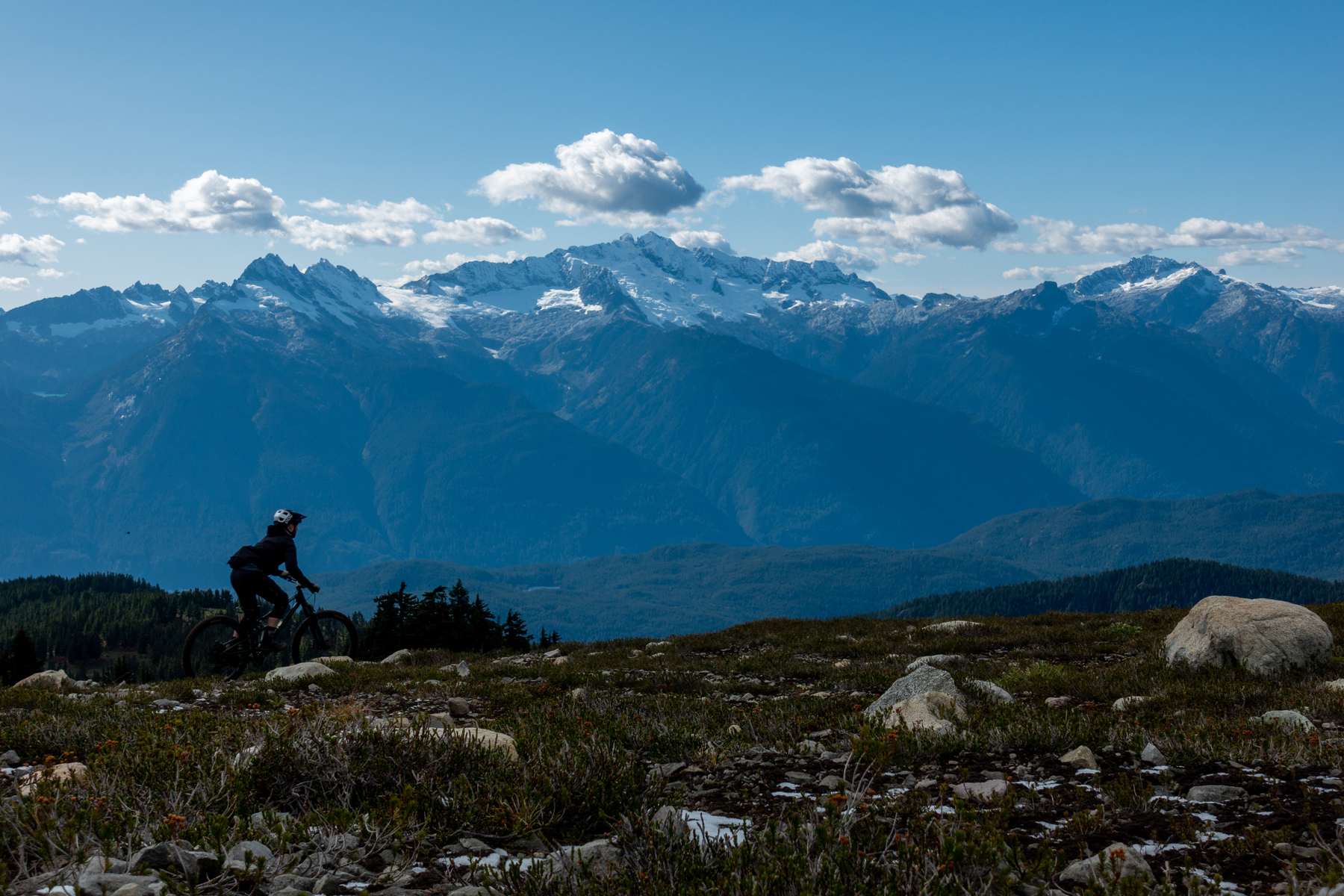
The MC also feels fairly adaptable in terms of its preferred body positioning, with a big sweet spot to move around on the bike. I’d wondered if the MC’s chainstays would feel unduly long; the 444 mm static chainstay length on our XL frame isn’t short to begin with, and it grows substantially due to the bike’s high-pivot layout. However, the MC just feels well-balanced and super intuitive.
The MC is, unsurprisingly, not a bike that I’d recommend to folks who want something especially playful or nimble, and there are better options if you specifically prefer a low cockpit setup and riding over the front of the bike. But I’ve found the MC’s handling to feel very intuitive and I needed very little adjustment period to get comfortable on it.
The MC frame isn’t especially stiff, but it doesn’t feel super flexy, either. I’ve been able to notice a little bit of give most readily when loading up the back end of the bike in a high-speed, well-supported corner (think a big bike park berm). In that scenario, it does feel possible to get the rear end to twist appreciably and consequently feels just a little bit vague in terms of how it’s tracking relative to the front.
I haven’t minded that much — the MC is far from being the flexiest frame I’ve been on in recent memory, and that bit of compliance from the frame likely helps with its outstanding levels of grip on choppy off-camber sections and the like. But if blowing up bike park berms all the time is your jam, the MC might feel a little vague. The MC’s levels of grip, especially on rough, poorly supported corners, on the other hand, are hugely impressive, and it’s especially adept at being loaded up through the pedals to settle the bike, find grip, and rail through the corner.
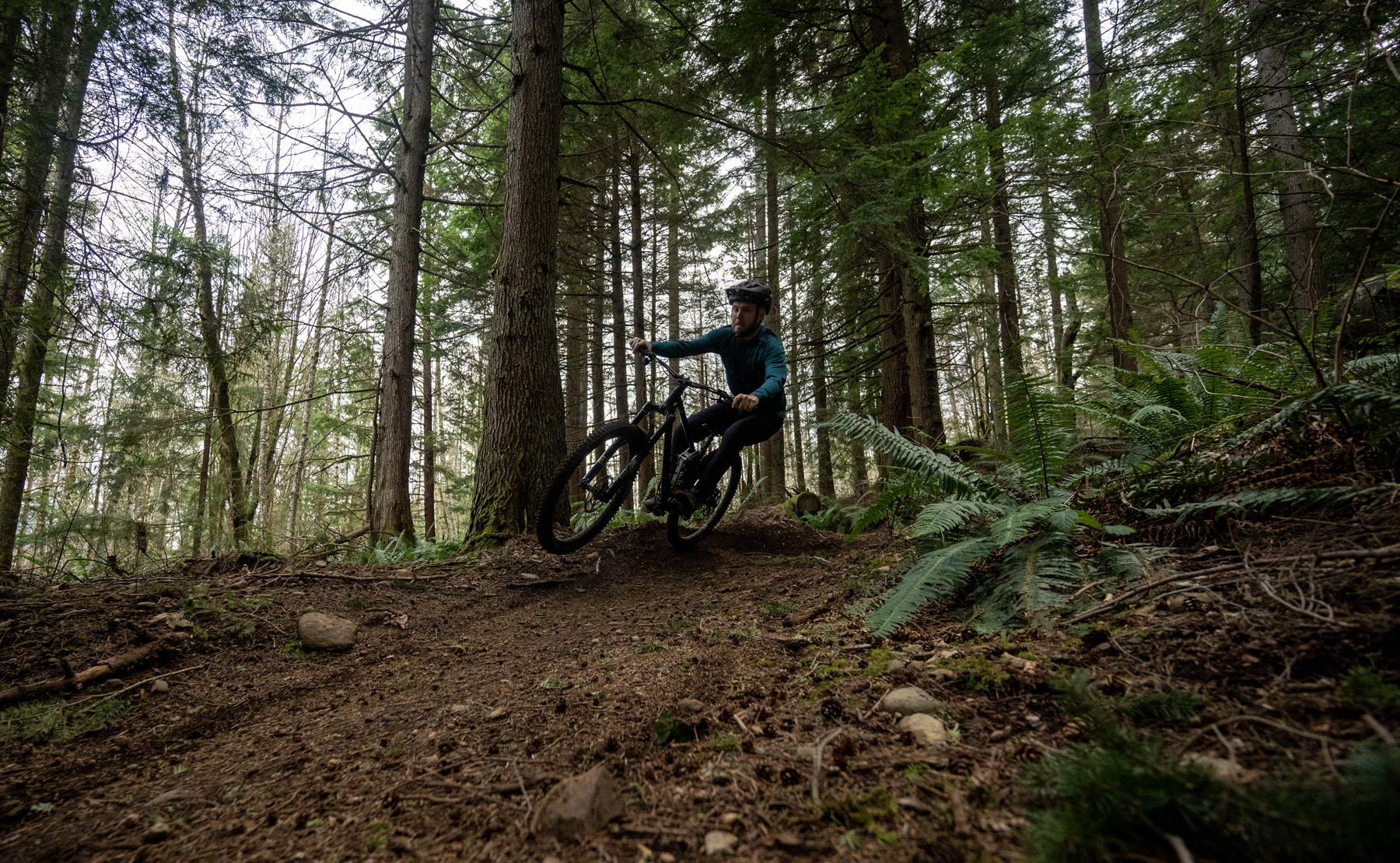
In sum, the MC feels like a bike that’s been designed with a very clear brief in mind — go fast on steep, rough, natural trails — and it’s impressively good at doing just that. The MC isn’t very engaging at lower speeds or on smoother, mellower trails, but it doesn’t need to be pushed all that hard to feel composed and comfortable and still offers an immensely high top end for when you want to get on it.
The Build
Contra offers the MC as a frame only, so there’s not too much to go into on the build spec. I set up the MC with a mix of review parts and some personal favorites. EXT handled suspension duties, with the stock Storia V3 shock in the back and the Era 2.1 (full review coming soon) up front. I had more than enough room to run a full 240mm-drop OneUp seatpost and rounded out the build with a SRAM X0 Transmission groupset and a few different brakes and wheelsets for testing purposes.
(Our measured weight of 38.7 lb / 17.6 kg is with the new Reynolds Blacklabel 309 Enduro Pro wheels, Hope Tech 4 V4 brakes, Continental Kryptotal DH tires, and Renthal Fatbar V2 aluminum bar, for reference. Contra also noted that our review bike had a couple of extra coats of powder coat due to blemishes in the original finish, which added an estimated 100+ grams.)
At 170 lb / 77.1 kg, I’m on the border between running a 425 or 450 lb spring on the Storia rear shock (according to Contra), and that proved to be right. I could happily run either, but generally preferred the slightly firmer, more supportive feel of the 450 lb one. I did end up running the rebound wide open with the 450 lb spring on the stock damper tune and wanted it a touch faster with the 425 lb one; EXT USA gave it a slightly lighter rebound tune partway through my testing, which made the overall adjustment range much more usable.
The overall fit and finish of the MC frame is great. The frame alignment is spot on, the pivot hardware is all high quality and easy to work on, and so on. The cable routing, which can be tricky to get really clean on high-pivot bikes in particular, is dialed. It’s fully external with zip tie mounts, everything runs cleanly without odd kinks, and it’s quiet / rattle-free. If I absolutely have to nitpick, it’d be nice if the mounts could accommodate slightly larger zip ties (not that I’ve had issues with them failing), but the MC’s routing is still better than the vast majority of bikes out there in my book.
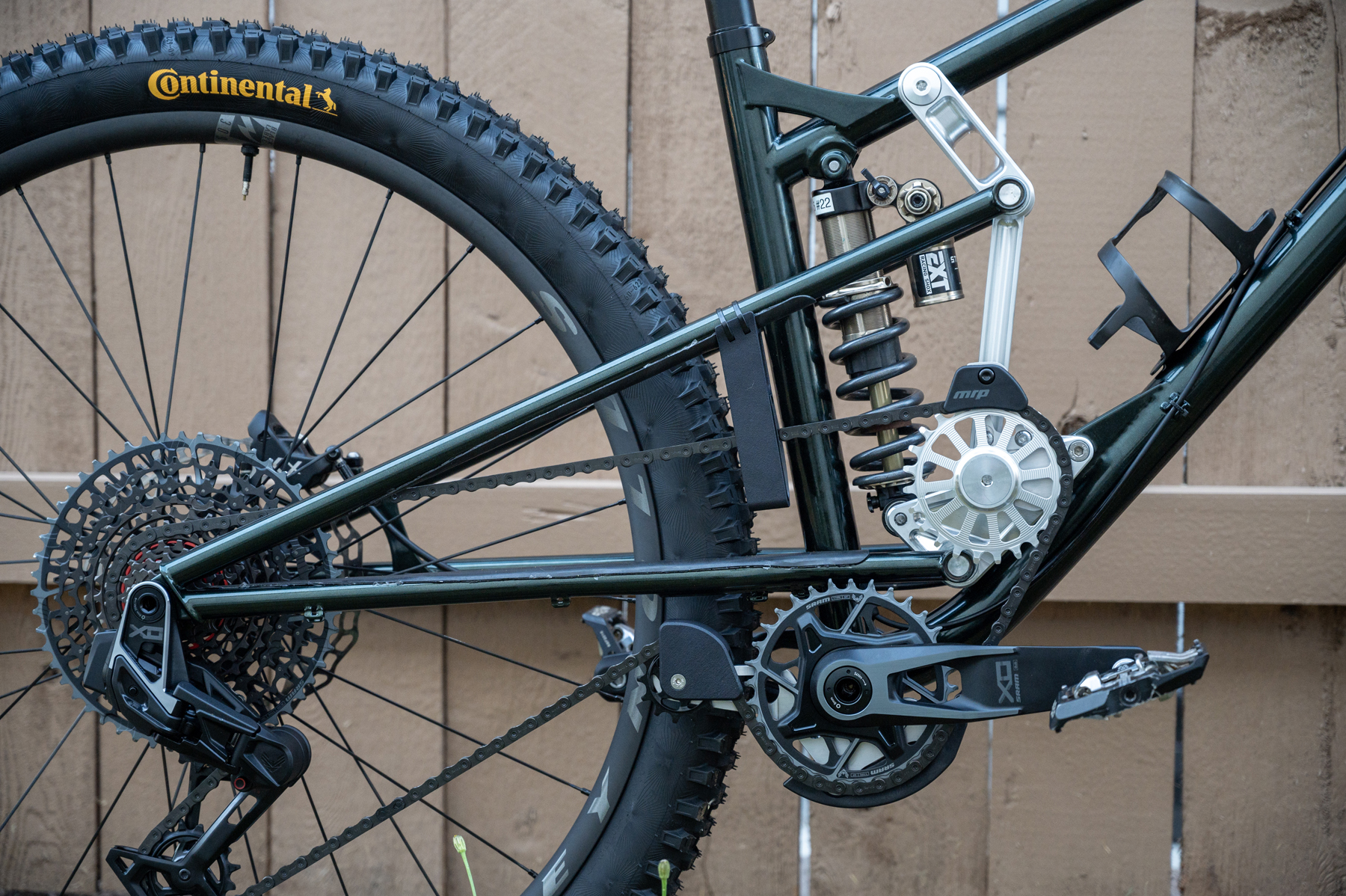
The one minor annoyance on the MC from a maintenance standpoint is access to the shock — the knobs are all easily accessible on the stock EXT Storia, but removing and installing it is a bit awkward. Contra’s recommendation is to close the rebound adjuster (so the shock is slower to return), loosen the preload collar on the spring, and compress the shock to snake it out. I found it easier to just undo the pivot axle between the upper link and swingarm to make more room.
That approach was particularly helpful with the RockShox Super Deluxe Coil that I briefly ran on the MC while the stock Storia was getting retuned, because there’s much less room to back off the preload collar on that shock, due to its longer spring. While the Super Deluxe performed pretty well on the MC, access to its high-speed compression and hydraulic bottom-out adjusters is poor with that shock installed on the MC frame.
It’s also worth noting that, due to the high-pivot layout, the MC requires different idler pulley and idler mount configurations, depending on whether you intend to run it with (A) a conventional drivetrain with a 52 mm chainline, or (B) SRAM’s new Transmission with its different chain profile and 55 mm chainline. Contra offers parts for either, but they are different, so plan accordingly.
I also needed 12 extra links (compared to a stock SRAM T-Type chain) when pairing the X0 Transmission drivetrain and a 32-tooth chainring on the XL MC. (Smaller frame sizes and smaller cassettes / chainrings will reduce the required chain length and vice-versa.) One extra chain should produce enough extra pieces for nine more future chains, so it’s not the biggest deal, but bear that in mind as well. If you’re on a smaller frame size and/or running a smaller chainring, your LBS might have a remnant from trimming someone else’s chain that’ll work. But for my specs, that was an optimistically big piece to find kicking around somewhere.
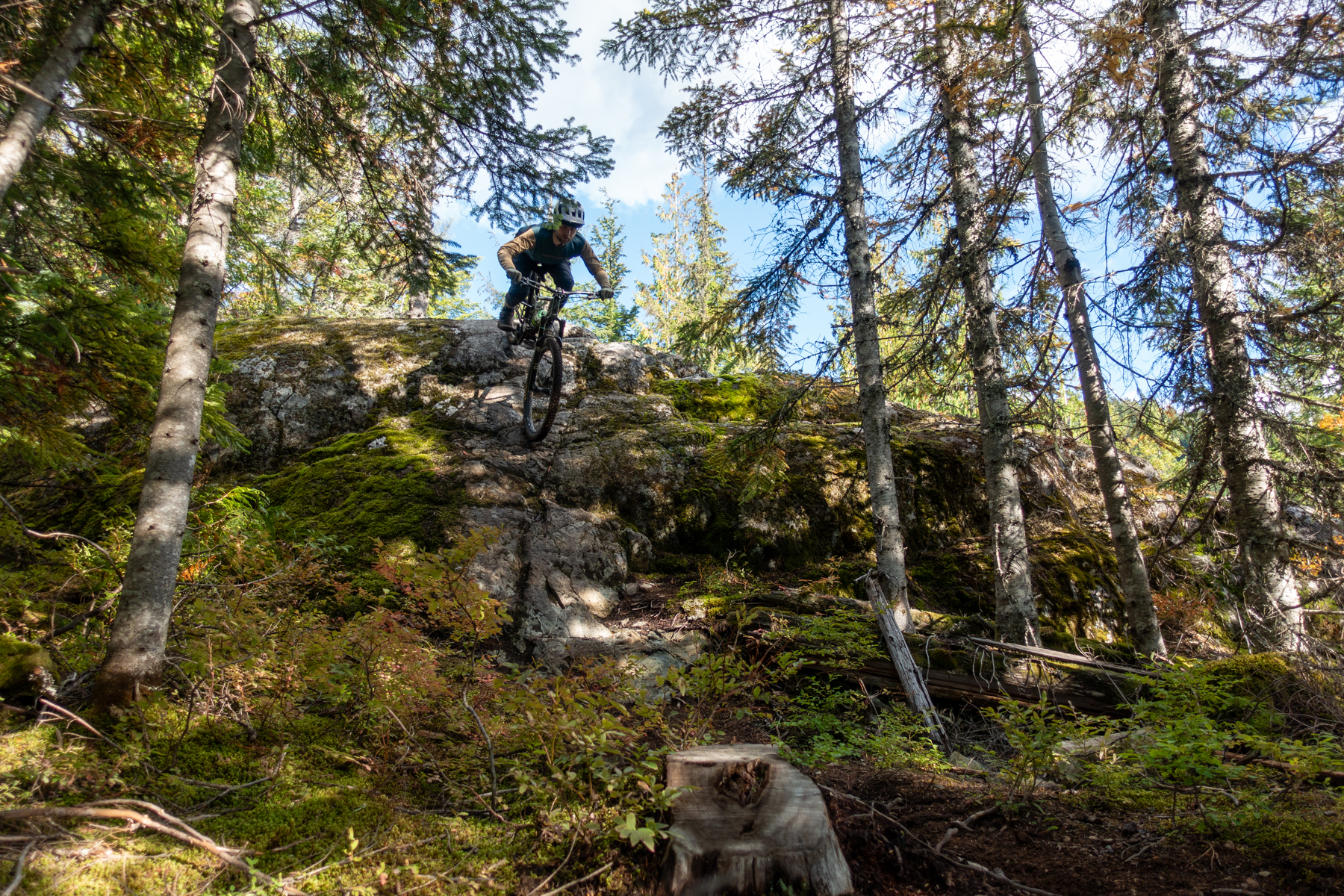
Who’s It For?
The MC is one of the most impressive bikes I’ve been on when it comes to offering a supremely composed, confidence-inspiring ride for going very fast on steep, rough trails — and pedaling back to the top. It’s not light, and not especially engaging on more mellow, rolling trails, but the combination of composure at speed, suspension performance, and pedaling efficiency that the MC pulls off is hugely impressive.
The MC also garners more attention at the trailhead than anything I’ve been on recently. It’s a striking-looking bike that you’re not likely to often see in the wild, and that really stands out in a sea of fat-tubed carbon-frame bikes. While the made-in-California steel construction doesn’t come cheap, the ride quality is phenomenal, and the finer details are especially well executed, from the super-clean external cable routing to the 200 or 203 mm rear brake mount (your choice of sizes). It’s a hand-crafted, built-to-order frame that just feels and looks special in a way that mass-produced carbon fiber frames can’t match, and all indications are that it’ll last an exceedingly long time. For the right folks, that’s worth paying for, and the MC earns its lofty price tag.
Bottom Line
The Contra MC just might be the closest thing to a true DH bike on the descent that still genuinely pedals well — at least of all the bikes I’ve ridden to date. While that’s still not quite a match for an actual DH bike when one of those is called for, if your idea of a good time involves grinding up long climbs to get to big, steep, fast descents, the MC is a seriously impressive tool for that job.
The real bottom line might be that I’m sufficiently impressed with the MC that I’ve bought one to be my personal Enduro bike and parts-testing platform for the foreseeable future. It’s a special bike and one that I’m very excited to keep logging big miles and big vert on in the years to come.
Deep Dive Comparisons
BLISTER+ members and those who purchase our Digital Access Pass can check out our Deep Dive comparisons linked below. Get our Digital Access Pass to view all our Deep Dives and Flash Reviews, or become a BLISTER+ member today to get access to that and a LOT more, including the best worldwide Outdoor Injury Insurance, exclusive deals and discounts on skis, personalized gear recommendations from us, and much more.
Check out our Deep Dive comparisons of the Contra MC to see how it compares to the Trek Slash, Norco Range, Kavenz VHP 16, Cannondale Jekyll, Forbidden Dreadnought, Cotic RocketMAX, Yeti SB160, Pivot Firebird, & Nicolai G1.

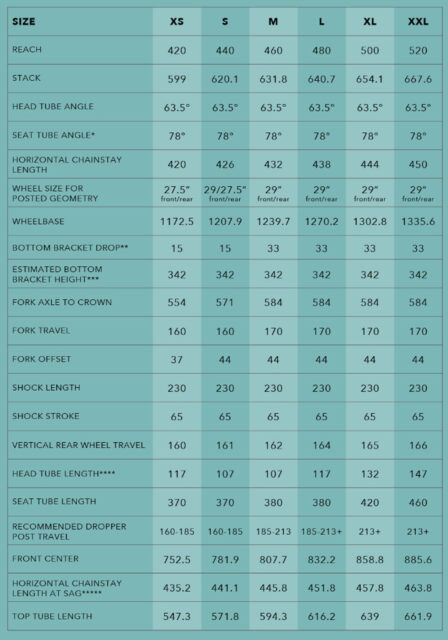
Interesting.
Steel ride quality could be a plus but what’s the weight?
Big bikes with a high pivot tend to be pretty heavy already.
Also the weld on that downtube bracket doesn’t look especially clean?
It’s not light, but not outrageously heavy. We’ll get a real measured weight when we get our long term review bike in.
The bike pictured is the prototype of what’s essentially the final production design. A few of the construction details are changing but the geometry and suspension kinematics aren’t.